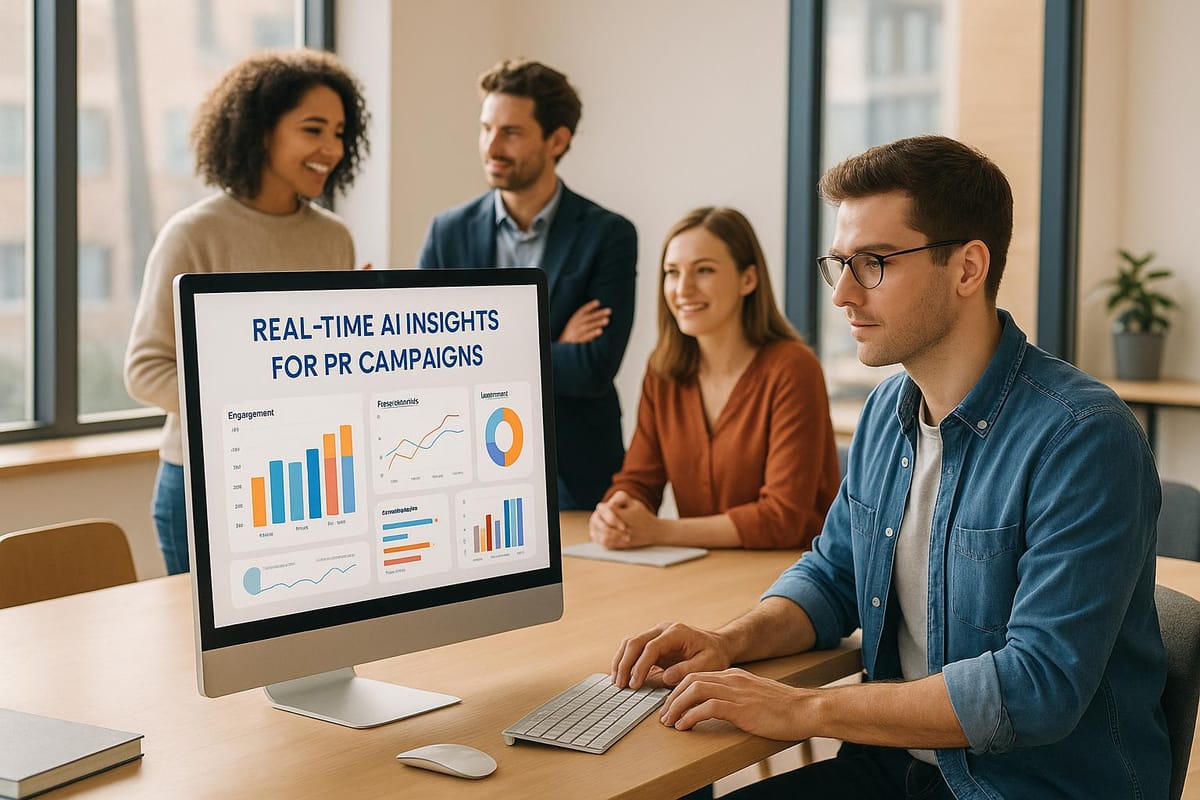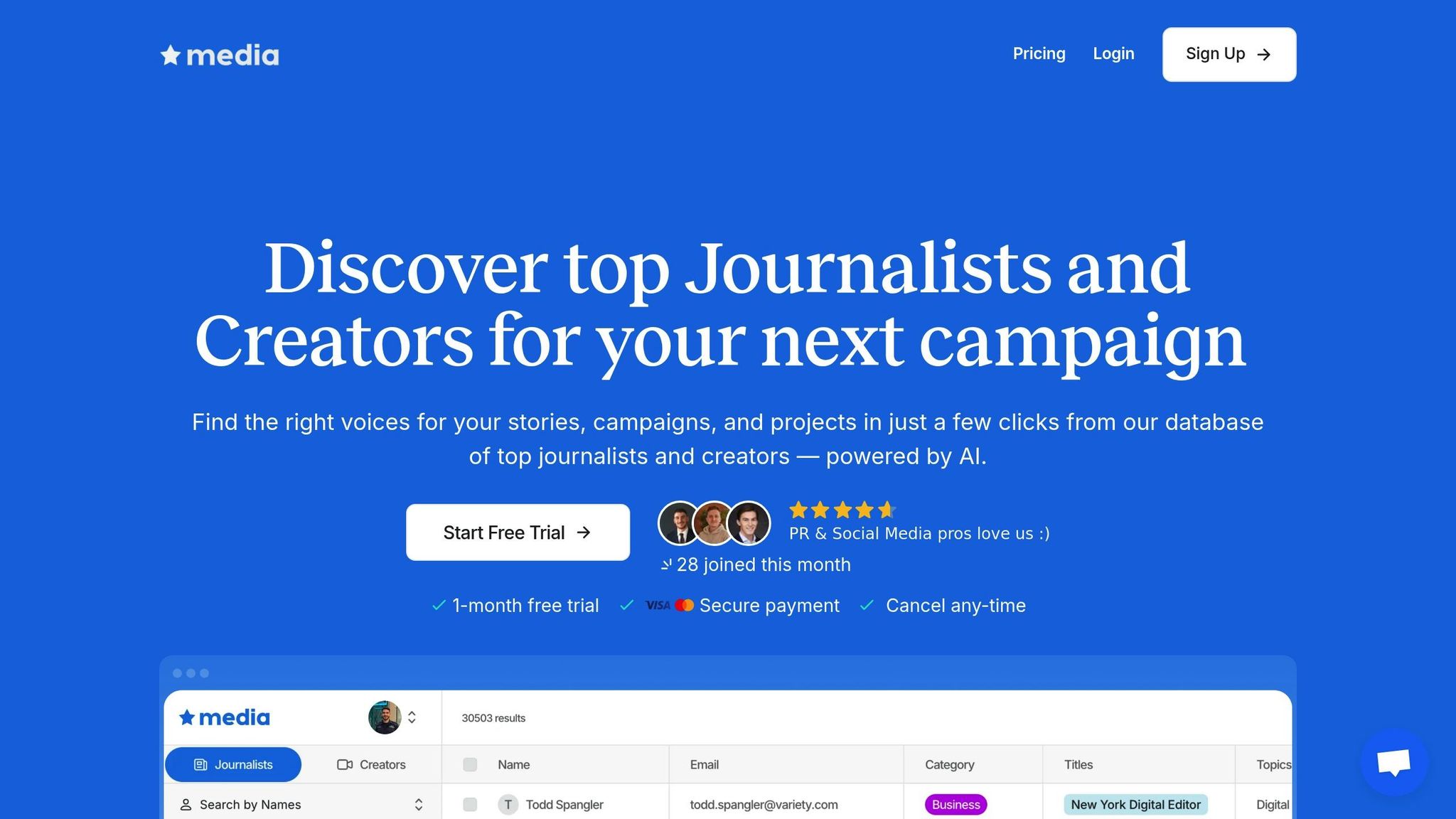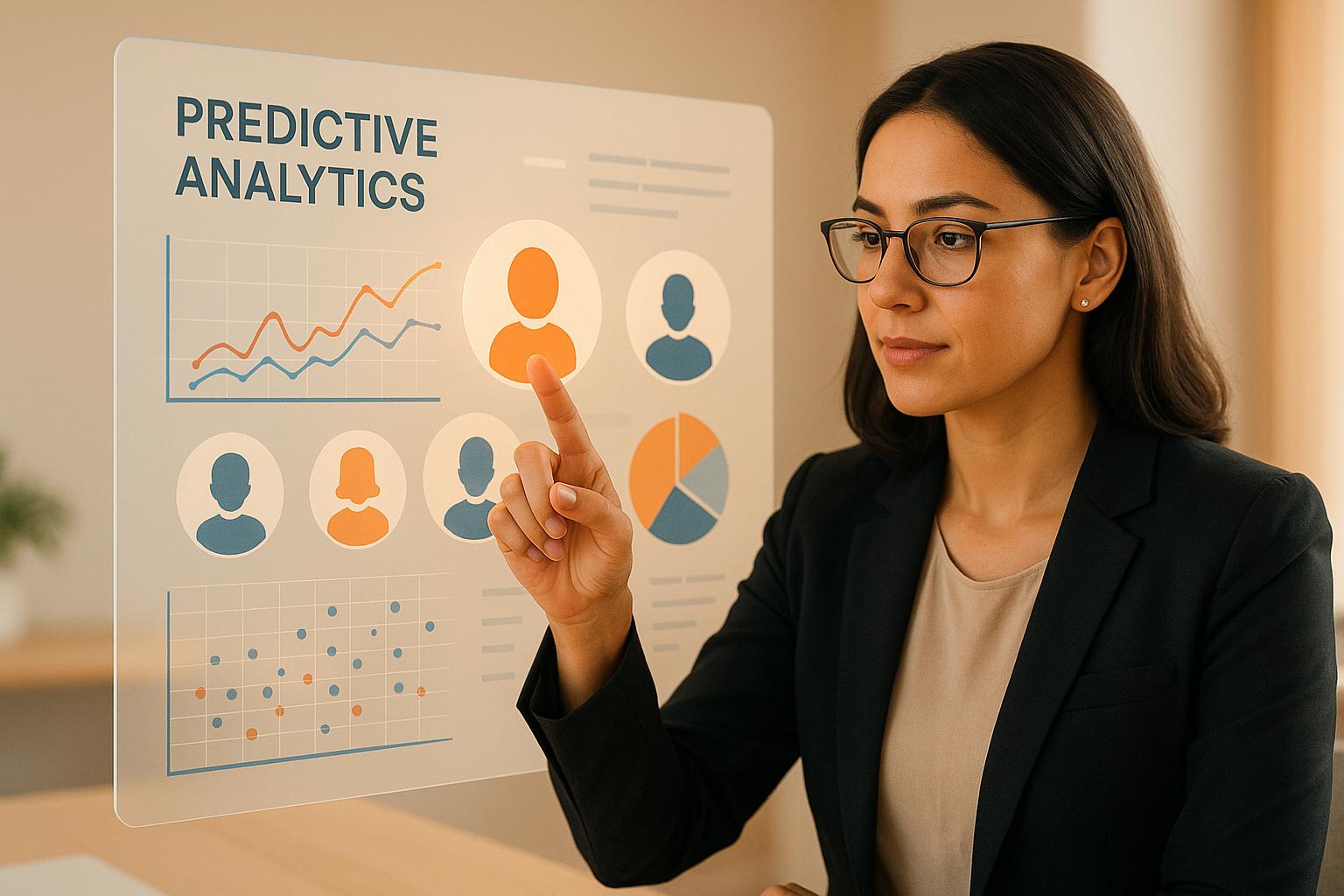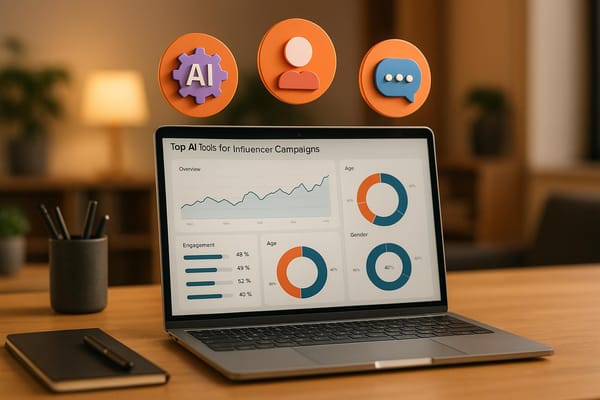Real-Time AI Insights for PR Campaigns
AI tools are revolutionizing PR campaigns by providing real-time insights, optimizing outreach, and enhancing crisis management for better results.

AI tools are transforming PR campaigns by providing instant insights, automating tasks, and improving precision. These tools help PR teams:
- Spot trends early: AI identifies emerging topics weeks before they peak, giving brands a competitive edge.
- Monitor media coverage: AI scans thousands of sources in seconds, ensuring no critical mentions are missed.
- Optimize outreach timing: AI analyzes journalist behavior to send pitches at the most effective times.
- Manage crises fast: Real-time alerts enable quick responses to potential issues, reducing reputational risks.
- Boost ROI: AI-driven personalization and automation improve campaign results while cutting costs.
For example, companies like Nike and Heinz have used AI to increase sales and engagement significantly. With 80% of PR professionals expected to adopt AI by 2026, leveraging these tools is becoming essential to stay ahead in a fast-moving media landscape.
How To Revolutionize Your Digital PR Strategy with AI for Maximum ROI | Webinar
Major PR Challenges and Why Real-Time Insights Matter
In today's fast-moving media environment, PR professionals face challenges that demand speed and precision. Traditional tracking methods often fall short, leaving teams struggling to keep up. Real-time AI insights have become a game-changer, offering PR teams the tools to tackle these challenges head-on. These insights are reshaping how trends are identified, media coverage is monitored, and outreach strategies are timed.
Spotting Trends Before They Peak
Missing out on a trend can cost weeks of valuable media attention. By the time traditional methods identify an emerging topic, competitors may have already seized the opportunity.
AI changes the game by analyzing massive amounts of social data in real time. For example, AI systems process over 15,000 social media posts every minute, identifying patterns across platforms almost instantly. These systems go beyond tracking spikes in mentions - they evaluate engagement rates, audience demographics, sentiment, and historical data to separate short-lived viral moments from trends with staying power.
The results speak for themselves: businesses using AI for trend detection have reported 37% higher engagement rates and a 22% boost in conversion rates. AI also updates its predictions frequently, ensuring they remain accurate.
Take Nike’s example in 2023. Using Salesforce's Einstein AI, the company spotted a growing interest in retro sneaker unboxing videos six weeks before the trend hit its peak. Acting quickly, they launched a targeted campaign that increased sales by 37% within their target audience. Similarly, AI tools helped fashion retailers identify the rise of the "quiet luxury" aesthetic 6–8 weeks before it became a media sensation.
This predictive power allows PR teams to fine-tune content strategies, shape messaging, and engage the right audiences before trends become oversaturated.
Monitoring Media Coverage Across Multiple Channels
The media landscape has grown far beyond traditional outlets. PR teams now need to track mentions across online news, print, TV, podcasts, radio, social media, blogs, and forums. Managing this manually is nearly impossible.
That's why around 65% of PR professionals now turn to AI to handle this overwhelming task. Tools like Agility PR Solutions, which indexes over 2 billion news items annually, provide much-needed support.
AI-powered monitoring tools offer real-time alerts for spikes in mentions or negative sentiment, enabling teams to address potential issues before they escalate. These tools don’t just rely on keyword matching - they analyze the sentiment behind mentions across all channels.
"Media monitoring allows you to track topics relevant to your organization and industry across print, online, and broadcast media output." - Signal AI
Visual dashboards make it even easier for PR teams to spot trends and assess public perception at a glance, streamlining the entire reporting process.
Better Outreach and Follow-Up Timing
When it comes to media pitching, timing is everything. Journalists are inundated with pitches daily, and reaching them at the right moment - when they’re not swamped by deadlines or breaking news - can make all the difference.
AI takes the guesswork out of this process by analyzing journalists' writing styles, past coverage, and engagement patterns to identify the best times to pitch. This data-driven approach ensures pitches are sent when journalists are most likely to engage.
"At Elliot & Co., we use AI-assisted platforms to map story angles to journalist profiles across Southeast Asia, tailoring every pitch to the right voice, at the right time." - Elliot & Co.
Real-time sentiment analysis also helps PR teams react quickly to changes in public perception. When breaking news creates new opportunities, AI can generate content immediately, allowing campaigns to stay relevant and timely. By moving from broad, scattershot approaches to precise, personalized outreach, PR teams can respect journalists' time and dramatically improve their chances of landing impactful coverage.
How Media AI Improves PR Campaigns

In the fast-paced world of public relations, having the right tools can make all the difference. Media AI is a specialized platform designed to provide PR professionals, startups, and agencies with quick and efficient access to media contacts. By simplifying contact research and reducing costs, Media AI helps streamline PR efforts. Let’s dive into how its features tackle key challenges in the industry.
Database of 30,000+ Journalists and Creators
Media AI boasts an extensive, AI-powered database of over 30,000 journalists and creators, focusing primarily on the U.S. market. The database is regularly updated to ensure contact details remain accurate and reliable.
"Media AI made it so easy to find the right collaborators for our campaign. It's a game-changer." - Sarah Jones, Marketing Manager, Remote3
This expansive resource allows users to connect with the right voices at the right time. Whether you’re looking for tech reporters covering artificial intelligence breakthroughs or lifestyle creators focused on sustainable living, Media AI’s intuitive search tools make the process seamless. Plus, users can export contact lists in formats like Excel or PDF, making it easy to integrate the data into existing CRM systems or campaign management tools.
Search and Filter Options for Precise Targeting
Using generic media lists often results in irrelevant pitches and wasted effort. Media AI addresses this issue with advanced filtering options that let users refine searches based on criteria like journalist names, locations, beats or topics of interest, media outlets, and specific roles.
What makes Media AI stand out is its ability to filter contacts using keywords from written articles and Tweets. For instance, if you’re launching a fintech product, you can identify journalists who’ve recently written about financial technology or discussed cryptocurrency trends on Twitter. This level of precision eliminates the inefficiencies of manual research.
Additionally, the platform includes location-based targeting, which is crucial for region-specific campaigns. Whether you’re targeting tech reporters in Silicon Valley or lifestyle journalists in New York, Media AI ensures you reach the right audience.
Affordable Pricing Without Long-Term Commitments
Budget constraints shouldn’t limit PR campaigns. Media AI’s flexible pricing model is designed to accommodate dynamic needs, offering an alternative to traditional media databases that often require costly, long-term contracts.
Here’s a breakdown of the platform’s pricing tiers:
- Journalist Database: $99/month
- Creators Database: $99/month
- Full Database Access: $149/month
This straightforward pricing structure allows teams to pay for only what they need, avoiding unnecessary expenses. The absence of long-term contracts is particularly beneficial for project-based work or seasonal campaigns, giving users the freedom to scale their usage as needed.
"I used Media AI to find the best journalists and influencers for our event. Their team is highly responsive." - Medet Serik, Executive Solutions Consultant, Huawei
Real-Time AI in Action: Practical Examples
Media AI and similar platforms showcase how real-time insights can shape effective PR strategies. By enabling swift responses to crises, seizing timely opportunities, and improving campaign results, real-time AI has become a vital tool across industries. Here’s a closer look at how these technologies are being applied.
Quick Crisis Management Response
When a crisis hits, every moment matters. AI-powered monitoring tools help PR teams identify potential problems before they escalate. Today, over 75% of PR professionals rely on AI for such tasks.
Take Uber, for example. The company uses AI-driven social listening to pick up on customer dissatisfaction early, allowing them to address issues before they snowball. Similarly, KLM employs AI chatbots during flight disruptions to engage with customers quickly, maintaining trust even during stressful situations.
"Using AI and social listening allows us to control the narrative before it controls us." – George, Seasoned PR Manager
By catching warning signs early, brands can act fast to minimize damage. Companies that respond promptly to emerging crises often see less harm to their reputation and stronger customer loyalty. This proactive approach also creates opportunities to use breaking news as part of timely campaigns.
Using Breaking News for Campaign Opportunities
Beyond crisis management, AI opens the door to newsjacking - capitalizing on trending topics to integrate brand messaging. In today’s fast-paced news cycle, manual monitoring isn’t enough. AI tools excel at analyzing search trends, social media chatter, and news patterns to spot opportunities. Notably, 78% of journalists turn to social media for expert commentary during fast-moving stories.
Apple’s response to the FBI encryption debate is a prime example of strategic newsjacking. By taking a public stance on privacy rights during the controversy, Apple secured coverage in major outlets like The New York Times and The Wall Street Journal. This move boosted their search rankings 40% faster than typical campaigns. Similarly, Ask Traders capitalized on retail industry disruptions to earn over 250 backlinks, while Parkdean Resorts gained 148 links by promoting virtual tours during lockdowns. Brands that engage in weekly newsjacking report a 63% boost in domain authority, highlighting the long-term SEO benefits of timely and consistent content.
Higher Campaign ROI Through AI-Driven Outreach
AI-powered tools are transforming outreach by making it more personalized and effective, leading to measurable improvements in campaign performance. According to McKinsey, companies deeply integrating AI see a 10–20% increase in sales ROI.
Heinz’s 2024 "A.I. Ketchup" campaign is a standout example, generating a record 1.15 billion earned impressions worldwide. AI-driven personalization ensures outreach is targeted and relevant by analyzing journalists’ coverage history and engagement patterns. Media AI’s extensive database allows PR teams to filter contacts based on specific keywords in articles and tweets, reducing wasted efforts and boosting response rates.
Businesses that use AI for customer interactions report a 10–15% increase in retention rates, while those adopting AI for process automation can see productivity jump by as much as 40%. These efficiencies free up PR teams to focus on building relationships and crafting strategic plans rather than getting bogged down by manual tasks.
"The agencies and brands that thrive will be the ones that leverage AI strategically while maintaining the human touch that drives meaningful media connections." – Molly Bell, Account Director, Consumer & Travel, Interdependence
Manual vs. AI-Powered PR Workflows: Side-by-Side Comparison
The transition from manual to AI-driven PR workflows has reshaped how public relations teams operate. While traditional methods have been the backbone of PR for years, the fast-paced and intricate nature of today’s media landscape calls for more efficient solutions. By comparing these approaches, teams can better understand which strategy aligns with their goals.
Comparison Table: Manual vs. AI-Driven PR Methods
The differences between manual and AI-powered workflows become evident when you break down specific tasks and their impact. Here's a closer look:
| Task | Manual Workflow | AI-Driven Workflow | Measurable Impact |
|---|---|---|---|
| Campaign Timeline | ~35 days to complete | Reduced to ~14 days | 60% faster execution |
| Media Monitoring | Limited by human capacity, reactive | Scans thousands of sources in seconds | 60% quicker response times |
| Trend Identification | Reactive to changes | Predicts trends 3-4 weeks ahead | 1.8x more likely to exceed objectives |
| Content Creation | Time-intensive manual research and drafting | AI-assisted research and drafting | 70% increase in efficiency |
| Press Release Distribution | Manual outreach and tracking | Automated distribution with analytics | 35% higher pickup rates |
| Cost Efficiency | High labor costs | Up to 20% savings in operational costs | $16M saved (Lenovo, 2024) |
These figures highlight the dramatic advantages of AI workflows over manual methods. AI can handle up to 35% of daily tasks, freeing teams to concentrate on strategic initiatives instead of repetitive work. This shift transforms how PR professionals allocate their time, making it a resource for creativity and relationship-building rather than routine tasks.
Traditional workflows often struggle with inefficiencies, especially as the media landscape grows more complex. For instance, 65% of marketers cite research and ideation as the most time-consuming aspects of manual processes. AI eliminates these bottlenecks by automating data analysis and initial content creation.
"AI's ability to be trained and adapt is a huge advantage over traditional automation. Because many AI systems can be trained with new data, refine their algorithms, and improve over time, AI automation solutions effectively manage complex and changing tasks that traditional systems can't handle." - MetaSource
Measurable Results from AI-Powered PR Tools
The benefits of AI in PR go beyond speed - they deliver measurable outcomes that redefine efficiency. AI-driven workflows have led to up to 70% better content efficiency, 25% more media coverage, and 20% lower operational costs.
One of the standout improvements is in response times. PR teams using AI-powered monitoring tools report 60% faster reactions to emerging issues compared to manual methods. In crisis management, this speed can be the difference between staying in control and losing the narrative.
Content quality and engagement also see a notable boost. Surveys show that 85% of PR professionals believe AI has improved the relevance and quality of press releases, and 75% of companies report spending less time on distribution and tracking. Even more compelling, brands using AI tools for distribution experience an 83% increase in content engagement compared to manual workflows.
The financial impact is equally impressive. Companies leveraging AI report a 5% annual revenue increase and a 20% reduction in operational costs. According to Forrester, 73% of organizations using AI in marketing see a higher ROI within the first year. This success stems from AI's ability to optimize campaigns in real time and uncover opportunities that manual methods might miss.
Perhaps the most game-changing aspect of AI-powered workflows is their predictive capabilities. Campaigns that utilize predictive analytics are 1.8 times more likely to exceed goals and 2.9 times more likely to drive revenue growth. This shift transforms PR into a proactive discipline, enabling teams to anticipate trends rather than simply reacting to them.
Real-world examples illustrate the impact of AI in PR. In 2024, Lenovo saved $16 million by using AI for content distribution, and Juniper Networks achieved a fivefold increase in meeting bookings with an AI-driven, personalized approach. These cases highlight how AI complements human expertise, amplifying the effectiveness of established workflows.
"AI isn't replacing great marketers - it's amplifying their proven workflows and freeing up time for even greater innovation." - Kelsey Libert, Search Engine Land
The efficiency gains from AI are particularly evident in large-scale campaigns. AI allows marketing teams to save 59% of the time previously spent on campaign management tasks, all while maintaining consistency that manual workflows often struggle to achieve. This newfound efficiency enables PR teams to focus on the human elements of their work - such as building relationships and crafting creative strategies - where their expertise is irreplaceable.
Early adopters of AI tools report 61.4% higher efficiency and 43.5% lower business costs. As more organizations embrace these technologies, the competitive edge of AI-powered workflows is expected to grow. With 80% of PR professionals projected to adopt AI tools by 2026, the ability to manage crises in real time and identify emerging trends will become essential for success in public relations.
Conclusion: Using Real-Time AI for Better PR Results
Shifting from manual processes to AI-powered PR is a game-changer, streamlining workflows, enabling quick responses, and delivering measurable improvements. As we've explored, organizations leveraging AI are not just working faster - they're seeing stronger results across every stage of their campaigns.
Key Takeaways
A staggering 80% of communication professionals believe AI is reshaping PR. Current data backs this up, showing that AI can accomplish tasks in seconds that once took days. This speed is crucial when managing the massive 181 zettabytes of data expected to exist online by 2025.
AI also brings personalization to PR on a large scale. With 81% of marketers reporting that customers now expect tailored experiences, this capability is becoming indispensable. Data-driven organizations are reaping the rewards: they are 23 times more likely to acquire customers, six times more likely to retain them, and 19 times more likely to be profitable.
One standout example is Media AI, which showcases how specialized tools are transforming PR workflows. With access to a database of over 30,000 journalists and creators, Media AI simplifies one of PR’s most challenging tasks - finding and connecting with the right media contacts.
Real-time AI also excels in crisis management. By delivering instant alerts about brand mentions and sentiment changes, these tools give PR teams the ability to act quickly and effectively in the face of emerging issues.
"AI does more than speed up tasks – it enhances our work. For communications professionals, AI takes care of routine tasks, letting us focus on creativity and strategy."
- Irena Merkaš, Communications Manager, Microsoft for Central & Southeast Europe
Additionally, over 60% of early AI adopters in fields like cybersecurity, product development, and sales report saving up to an hour daily. For PR professionals, this extra time can be redirected toward building relationships, crafting impactful narratives, and designing strategic campaigns that resonate deeply. These benefits highlight AI’s growing role as a tool where efficiency and creativity intersect.
What's Next for AI in PR
Looking ahead, the role of AI in PR is set to expand even further. With 71% of PR professionals considering AI critical to the future of their industry, it’s clear that adoption is only gaining momentum. As AI continues to evolve, we can expect advancements in areas like sentiment analysis and content creation.
However, the future of AI in PR will likely focus on collaboration, positioning AI as a creative partner rather than merely a tool for efficiency. The human elements of PR - creativity, emotional intelligence, and strategic thinking - will remain irreplaceable. The challenge for PR professionals will be to strike the right balance: leveraging AI’s speed and data capabilities while preserving the personal touch that defines impactful public relations.
The competitive edge will belong to those who adopt AI thoughtfully and strategically. As Harvard Business School's Karim Lakhani aptly puts it:
"AI is not going to replace humans, but humans with AI are going to replace humans without AI"
For PR teams, the question isn’t whether to use AI - it’s how quickly and effectively they can integrate it while staying true to the strategic and creative core of their work.
FAQs
How can AI tools help PR professionals improve the timing and success of outreach to journalists?
AI tools are transforming PR outreach by pinpointing the best timing and most relevant audience for campaigns. These tools can study patterns in journalists' behavior, like when they’re most likely to respond to pitches, ensuring outreach happens at just the right moment.
Platforms like Media AI take it a step further by helping PR teams focus on journalists with specific interests and track records. This means pitches can be tailored to align with what each journalist truly cares about, boosting response rates and fostering stronger connections. With these data-driven insights, PR professionals can make their campaigns more impactful while streamlining their efforts and resources.
What advantages does AI offer for media monitoring over traditional methods?
AI-powered media monitoring brings a range of benefits that outshine traditional methods, making it a game-changer for modern PR campaigns. One of its standout features is the ability to process massive amounts of data in real time. This means PR teams can quickly track media coverage and spot trends much faster than they ever could with manual efforts. The result? Timely responses to both challenges and opportunities.
Another advantage is greater precision in sentiment analysis and media tracking. AI minimizes the chances of overlooking crucial insights, ensuring nothing important slips through the cracks. Plus, these tools are incredibly scalable, making them suitable for campaigns of any size or complexity. Together, these features empower PR teams to refine their outreach strategies, strengthen media relationships, and boost overall campaign results.
How can AI help PR teams manage crises and respond to breaking news effectively?
AI gives PR teams a powerful edge in managing crises by offering real-time monitoring across social media and news outlets. This capability helps teams spot potential problems early, respond promptly, and shape public perception more effectively. Whether it’s drafting press releases, prepping spokespeople, or tracking media coverage under pressure, AI supports PR professionals in containing damage and preserving trust.
During breaking news situations, AI tools can instantly analyze industry trends and news developments. This allows PR teams to react quickly with strategic messaging or seize emerging opportunities, keeping their organization relevant in the fast-paced media world. By simplifying these tasks, AI enables PR teams to tackle challenges head-on and stay one step ahead.





